|
Thurs., May 24
1:00 p.m.
ALCPG ILC Physics and Detector Seminar - WH-10NW, West Wing
Speaker: C. Milstene, Fermilab
Title: Precision Measurement of the Stop Mass at the ILC
2:30 p.m.
Theoretical Physics Seminar - WH-3NW (NOTE LOCATION)
Speaker: D. Tucker-Smith, Williams College
Title: Mixed-Sneutrino Dark Matter at the LHC
3:30 p.m.
DIRECTOR'S COFFEE BREAK - 2nd Flr X-Over
THERE WILL BE NO ACCELERATOR PHYSICS AND TECHNOLOGY SEMINAR TODAY
Fri., May 25
3:30 p.m.
DIRECTOR'S COFFEE BREAK - 2nd Flr X-Over
4:00 p.m.
Joint Experimental-Theoretical Physics Seminar - 1 West
Speaker: M. Rama, University of Pisa
Title: Measurement of g at BaBar
Click here for NALCAL,
a weekly calendar with links to additional information. |
Thursday, May 24
-Santa Fe black bean
-Sloppy Joe
-Chicken cordon blue
-Sauteed liver & onions
-Baked ham & Swiss on a ciabatta Roll
-Assorted sliced pizza
-Crispy fried chicken ranch salad
*Carb Restricted Alternative
Wilson Hall Cafe Menu |
|
Thursday, May 24
Dinner
- Tomatoes, fresh mozzarella & basil salad
- Grilled halibut w/ spicy pimiento sauce
- Spinach risotto
- Julienne of multicolored pepper
- Pears & hazelnut soufflé
Wednesday, May 30
Lunch
- Pad thai salad w/shrimp & green onions
- Cabbage, red pepper & carrots
- Coconut flan
Chez Leon Menu
Call x4598 to make your reservation. |
|
|
FNAL and ANL collaboration
meeting focuses on future
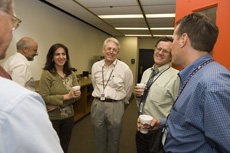 Last Friday's collaboration meeting between key Argonne and Fermilab employees allowed attendees to mingle during breaks. Argonne Director Robert Rosner is pictured second from the right.
Last Friday's collaboration meeting between key Argonne and Fermilab employees allowed attendees to mingle during breaks. Argonne Director Robert Rosner is pictured second from the right.
Optimism and eagerness were pervasive last Friday as dozens of key members from Argonne National Laboratory and Fermilab listened to each other speak. More than 50 Argonne and Fermilab employees came together for a collaboration meeting last week to discuss the two institutions' opportunities for synergy and their plans for the future.
The meeting was the second for the two groups, who originally met at Argonne in November. The second meeting, Fermilab deputy director Young-Kee Kim said, really opened the eyes of employees at both institutions to the collaboration possibilities. "The first meeting was mainly ILC oriented," Kim said. "Then we realized that we can work together in so many other areas."
Historically, the two laboratories have not spent much time collaborating, but, Kim said, their common affiliation with the University of Chicago and similar goals have brought the desire to work together to the forefront. Argonne's multipurpose nature is a boon to Fermilab, ANL Director Robert Rosner explained at the meeting, highlighting both superconducting RF facilities and materials science as examples of areas that could contribute to the ILC. "The kinds of science we do and technology we pursue do have overlaps with the types of science that is done at Fermilab," he said. "If you think about the core missions of the lab, a lot are tied up with accelerators."
Hendrick Weerts, HEP division head at Argonne, attended the labs' detector R&D working group meeting on Tuesday at the University of Chicago and the Superconducting RF materials working group meeting on Friday morning, before joining the larger collaboration meeting. There was also a cosmology computing working meeting Friday morning.
"They were extremely useful," said Weerts. "It was very much a collaborative experience; there was no anxiousness. In the past there seemed to be a hesitation and that seems to be going away." Prior to his one and half year employment at Argonne, Weerts conducted research as a user at Fermilab while employed at Michigan State University for 25 years.
"People are able to see how collaboration and working together benefits us. We're doing kind of the same thing, we've got an emphasis on accelerators at both labs, even though we are using them for different things," Weerts said. "Argonne can bring something to the table. We're a multipurpose lab, and we can contribute in the physical sciences," Weerts said.
-- Rhianna Wisniewski
|
Local student receives Fermilab Friends scholarship

Kathleen Stanley of Warrenville, a graduating senior at Rosary High School in Aurora, has been named the recipient of the Fermilab Science Award and scholarship, sponsored by the Fermilab Friends for Science Education and the Franklin Fund. The award and scholarship were presented last night, May 23, in a ceremony at Rosary High School.
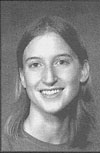 |
| Kathleen Stanley |
The award is given annually to a high school senior in DuPage or Kane County, with considerations for academic achievement, participation in activities such as science clubs, academic competition, talent searches, original work and internships. The $1,000 scholarship, awarded this year for the first time, is provided by FFSE in partnership with Paul DesCouteaux, Geneva, of the Franklin Fund.
Stanley, who hopes to major in chemical engineering in college, participated in Rosary's Math and Chemistry WYSE teams, representing the school in the Illinois State Finals in Champaign. She is president of the school's National Honor Society chapter, and a member of both Mu Alpha Theta (National High School and Two-Year College Mathematics Honor Society) and the Foreign Language Honor Society. She is also a two-sport athlete, received the Coach's Award in both soccer and basketball.
Read More
|
From Star Bulletin
May 22, 2007
UH scientist advocated academic freedom
Vincent Z. Peterson taught high-energy physics at the University of Hawaii for 30 years and worked with other physicists on experiments at leading research centers on the mainland.
He is remembered beyond his own field of science because "he was keenly interested in the academic environment and the preservation of academic freedom," said UH physics professor Michael Jones.
Peterson, 85, died Thursday in Berkeley, Calif.
"A lot of people outside the sciences remember Vince for what he contributed to forming academic policy and the academic atmosphere on campus," Jones said. Peterson was elected to several terms on the UH Faculty Senate. He upheld the right of a scientist to pursue research, a debate that was revived last year over the proposed creation of a University Affiliated Research Center at Manoa that raised opposition to classified military aspects of work to be done there.
Read more
|
|
|
The strong, the weak and the invisible
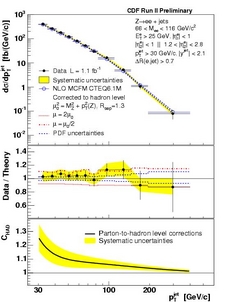
Measured inclusive jet cross section in events where a Z boson is produced with jets. The top plot shows the number of jets as a function of the momentum of the jets, ranging from 30 to 400 GeV/c. The middle plot demonstrates the data agree well with theory, so that data/theory is approximately 1.
In their quest to search for new physics at the Tevatron scientists try to extract tiny exotic signals from a huge background of "known" processes. But, how well are those known? Sometimes this is hard to tell. Interesting new physics processes often involve complicated topologies whose backgrounds are difficult to predict theoretically and therefore require experimental input.
One particularly tricky background is events in which a Z boson, a mediator of the electroweak interaction, is produced together with high energy gluons, mediators of the strong interaction, and quarks. These quarks and gluons reveal themselves as collimated flows of particles called "jets." About 20 percent of the time, the Z will decay to two neutrinos, which are invisible to the CDF detector, thereby leaving an unmistakable event signature of multiple jets recoiling against something invisible. This is virtually the same topology as those produced by new physics processes such as supersymmetry, Higgs, or extra dimensions. Fortunately, the complicated quark and gluon dynamics which create this "Z+jets" background can be studied using events in which the Z boson decays to visible particles.
A team of physicists from the CDF collaboration has performed a detailed analysis of jets production for events where the Z boson decays into an electron and positron, which occurs about 3 percent of the time. The measured jet energy spectrum and jet multiplicity have been compared with predictions from Quantum Chromodynamics (QCD). The measurements indicate that QCD inspired models properly describe these events, creating confidence that new invisible particles produced with jets could be distinguished from the background.
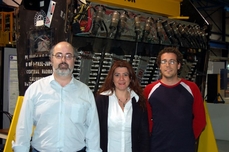
CDF members involved in the analysis (from left) Mario Martinez, Monica D'Onofrio, Oriol Salto (IFAE-Barcelona).
Learn more
|
DZero: Doing Double Duty
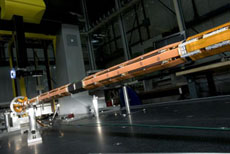
Summer 2006: A new layer of silicon detector is ready to fit in the center of the DZero detector.
Image courtesy of Dmitri Densiov, Fermilab
On the hunt for physics beyond the Standard Model, some DZero physicists search for traces of super-symmetry, lepto-quarks, quark substructure and other curiosities. Others continue to probe the Model, the theoretical backbone of modern high energy physics, by making ever more precise measurements.
DZero, located at Fermi National Accelerator Laboratory, Illinois, U.S., is a "general-purpose high energy physics experiment." As such, the DZero detector slices and dices a broad range of particles and phenomena that only Fermilab's Tevatron, currently the world's highest energy particle accelerator, can produce.
Read More
|
|
Stken Pnfs/Enstore/Dcache system downtime Thursday
There will be a downtime of the Stken Pnfs/Enstore/Dcache system Thursday, May 24 from 7 a.m.- noon. Several things will be worked on, so the entire system will be unavailable. This includes:
Stken Pnfs, Stken Enstore all robots. (FCC and GCC), and Stken Dcache.
The customers that will be affected are: all Public Stken users, CDF, CMS users of the SL8500 in GCC and SDSS in the ADIC.
We will be upgrading: Enstore code, Dcache patches, and Optimize Pnfs database.
Village Pool opening
The village pool will open full time for the season on Sunday, May 27 at 10:00 a.m.
NALWO Woodlands Tour Friday
Join NALWO on Friday, May 25 from 11:30 a.m. to 1:00 p.m. for their second Fermilab grounds walk in the Nalwo Naturalist Series. Learn how to identify woodland plants, some including that have medicinal properties. Then study the soil and insect life supporting this ecosystem. Meet in the parking lot of the Lederman Science Education Center. Please bring a bottle of water each, insect repellent and once again pants, socks and closed toe shoes even if the weather is warm. Please RSVP to Rose Moore at (630) 208-9309 or by email.
Additional Activities
|
|